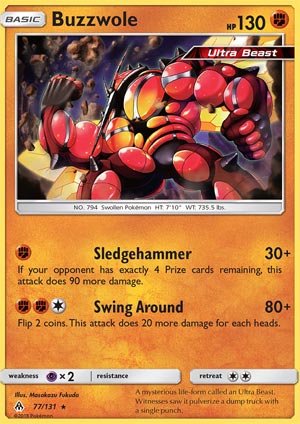
#6 – Buzzwole
– Forbidden Light
Date Reviewed:
December 24, 2018
Ratings Summary:
Standard: 3.63
Expanded: 3.83
Limited: 4.25
Ratings are based on a 1 to 5 scale. 1 is horrible. 3 is average. 5 is great.
Reviews Below:
 21times Buzzwole (FLI 77) burst onto the scene out of the Forbidden Light expansion set and instantly impacted the Pokemon Trading Card Game. It initially was a one of in Buzzwole GX lists, but eventually started to see more usage. Baby Buzz eventually reached its height of dominance in the Santa Catarina Regional on September 8th when each of the top eight lists was a four of Buzzwole archetype (most were Garbodor GRI a couple were Weavile UPR). Baby Buzz had actually surpassed Big Daddy Buzzwole GX in prominence, mostly because of Shrine of Punishment (CES 143), but also because it can function as a very effective single prize attacker. Since then, Buzzwole has all but disappeared from the meta. You have to go down into the twenties to find the first Buzzwole deck at the most recent tournament at Harrogate. There is some Ultra Beast hate out there (most notably Sceptile CES 10), but I think that most people have kind of tossed it aside because of all of the Psychic Pokemon running around. When Psychic Toolboxes took over after Philadelphia and Memphis back in September and early October, that made it really tough to play the Buzzodor archetype, even if they are all single prize attackers because these Psychic Toolboxes could put out a bunch of single prize Pokemon as well… and Buzzodor archetypes were completely weak top to bottom to them. So it’s been a bit of a roller coaster for Baby Buzz in its eight months of existence, but it is a good card that can completely abuse Beast Rings and will still make for a tough six prize matchup against non Psychic decks. The Sledgehammer tactic – swooping in after your first Buzzwole GX gets KO’d to do 120+ damage for only a single energy – has been one of the single most popular and effective strategies all year, and Swing Around can be easily powered up with Beast Rings and do a ton of damage turn after turn. Rating Standard: 3.5 out of 5 Conclusion I only gave this a 3.5 for a couple of reasons. I actually had more success with Zygarde FLI 72, pairing it with Max Elixirs and Drampa GX back in the previous season. Plus, that Psychic weakness really relegates both Buzzwoles to ancillary roles at this point. It’s tough putting a Psychic weak deck out there right now. Still, as long as you’re not going up against Sceptile or a Psychic Toolbox, a baby Buzzwole archetype will probably do pretty well for you. |
 Otaku We begin the week with Buzzwole (SM – Forbidden Light 77/131), the sixth-place finisher in our countdown of the Top 11 Cards of 2018! Why are we doing a Top 11 instead of our usual Top 10? The year ends on a Monday, and so it seemed appropriate. What is harder to explain is why Buzzwole did not make our Top 10 Countdown for SM – Forbidden Light. We have reviewed Buzzwole once before. Regrettably, I ran late and had to submit a short review without even including a score. Today I can correct that by giving it a proper review. Buzzwole is a [F] Type, which is usually a good thing because both now and historically, [F] Weakness is almost universal on [D] and [L] Pokémon, and quite common on [C] Types as well. [F] Resistance is typically one of the most common forms of Resistance, but the Resistance mechanic is not as influential as that of Weakness, and “No Weakness” is by far much more common. Anti-[F] effects exist in both the Standard and Expanded Format, but rarely prove competitive, while [F] Type support has proven quite effective, owing mostly to multiple examples of simple damage bonuses. Buzzwole is a textbook example of how useful it is being a Basic Pokémon. Whether you’re running a full four copies or just a single, Buzzwole is space-efficient and fast to the field. Buzzwole is NOT a Pokémon-GX. The importance of such an obvious thing will become more and more relevant as this review progresses. Being a Basic allows it open and to better take advantage of things such as bounce or search effects. There are some effects which punish a player for using a Basic Pokémon, but also some that reward Basic Pokémon usage; combined with the rest, this is blatantly a net positive. I’m not sure how much longer it will remain that way, but 130 HP is around the point where surviving an attack becomes more likely instead of less. [P] Weakness has been dangerous the entire time Buzzwole has been legal. There were strong [P] Type attackers when Buzzwole first released and there continues to be them now. There are also other [P] Weak Pokémon so building a deck to exploit this Weakness is quite valuable. Both a lack of Resistance and a Retreat Cost of [CC] are typical, with the latter being an issue at times. Buzzwole has two attacks. The first is “Sledge Hammer” for [F] and does 30 damage, plus another 90 so long as your opponent has four Prize Cards remaining. The second is called “Swing Around” and costs [FFC], while doing 80 damage and having you flip two coins; each “heads” is worth an additional 20 damage. Sledge Hammer makes Buzzwole a must-run as at least a single in any deck that can supply the [F] Energy it requires. Your opponent can try and avoid ever having four Prizes in play, but you can then turn that back to your advantage with a proper approach to setting up. An example is if you need to discourage your opponent from OHKOing a Pokémon-GX early in the game. Swing Around does a decent amount of damage for the Energy it requires but the coin flips make it a bit unpredictable. Without some potent Energy acceleration Swing Around also looks too slow to use well. However, actual results proved that early appearances can be deceiving. That is where it all comes together. [F] support like Brooklet Hill, Diancie {*}, Regirock-EX, and Strong Energy eventually either combined or were replaced by Ultra Beast support. Namely, Beast Energy {*} and Beast Ring. Add a Choice Band to the pile, and even without the effect of Sledge Hammer kicking in, it became a useful harassment attack early game. Even if your opponent managed to jump from five Prizes remaining to only three, Beast Ring could ready a swarm of Buzzwole. The attack was still annoyingly variable in its exact damage output, but even the worst-case 80 damage was useful with a Choice Band and Diancie {*} to go with it. This has been especially true in a metagame where Zoroark-GX is rarely unimportant and where not being a Pokémon-GX is valuable in and of itself. Buzzwole was originally used to supplement Buzzwole-GX, but not only did their relationship quickly reverse but we started seeing Buzzwole run without Buzzwole-GX. By the end of this year, we’ve learned Buzzwole can actually headline or costar in a decent variety of attacks, including those that run no Pokémon-GX. No Pokémon-GX makes it almost impossible to miss the timing for Sledge Hammer or Beast Ring. This carries over to the Expanded Format, where Buzzwole has seen similar success, only slightly muted by the larger cardpool. Is Buzzwole still dominating the top cut as 2018 draws to a close? The most recent, major Standard Format event for which I have results is the Regional Championship that was held in Harrogate, Great Britain. There are some gaps, but unless one happens to contain a Buzzwole deck, it was part of the deck that took 25th place. If that doesn’t sound good, this was out of 488 Masters Division players; that’s the Top 5.13%! Yes, I wish it was an even, round number, but that’s still quite good. We have a just as recent Expanded Format Regional Championship, which was held in Anaheim, CA. Again, the data is still incomplete but the eighth-place deck included one. The turnout was 508 Masters this time, which means that deck finished in the top 1.58%! These would be good for a card that just released, and for one that has been around seven months and which players have learned how to best play against, it is most impressive. Speaking of impressive, while it is unlikely you’ll get to use Buzzwole in a Limited Format event, as those are usually Pre-Release tournaments, Buzzwole is amazing here. Not only do the usual factors of its HP and damage output being more impressive here, where players have to run decks built around what they pull from the allotted packs, but the game BEGINS with Sledge Hammer doing 120 for [F]. I didn’t mention this earlier, but one of the advantages the conditions of Sledge Hammer has over the many other Prize-based attacks found on Ultra Beasts is that taking a KO won’t change your opponent’s Prize count. In the Constructed Formats, you’re lucky to get a second shot with Sledge Hammer; Buzzwole isn’t fragile, but neither is Buzzwole so durable you expect it to survive having been Active. When it happens, though, you get a second strike doing 120 for just [F]. While risky, it is a reasonable strategy to run a +39 (or Mulligan) build of Buzzwole. With no other Basic Pokémon in your deck, you’re guaranteed to open with Buzzwole. If you win the coin toss, let your opponent go first so you can immediately do 120 and (most likely) take a Prize. Attack three more times, always doing 120, and your typical Limited Format deck will need some luck to take Buzzwole down before that fourth OHKO. You can also play it safe and just include it in any deck that has room for some [F] Energy; even if Buzzwole doesn’t get its bonus damage on Sledge Hammer, it is still a big, strong Basic. Ratings
Buzzwole is a great card. Is it as great as when it first released? Perhaps not, but I like my year-end countdown to consider the entire year and not just the snapshot that is the last few days, weeks, or even months. I think it has been a bit since Buzzwole won a major event, and it isn’t finishing as high as it once did, but that isn’t a dramatic decrease. There’s a reason data is open to interpretation, and I’m seeing a deck with the kind of cyclical performance I expect of metagame mainstays. Maybe Buzzwole will fall further and further during 2019, but I expect it to remain relevant to the top 10% of the metagame. |
 Vince Buzzwole from Sun & Moon Forbidden Light is famous for its Sledgehammer Attack, which does 30 damage for a single Fighting energy, plus 90 more if your opponent has exactly four prizes remaining. With Beast Energy, Diancie Prism Star, and other Fighting support from Expanded, Buzzwole can potentially KO most of the Basic GX Pokemon when such an opportunity arises. Your opponent can try to play around with this, but they might not account for situations where you knock out your own Pokémon to being the prize count down to four. With Shrine of Punishment, it helps Buzzwole secure KOs faster. Ratings: Standard: 4/5 (Diancie, Beast Energy, and a Choice Band makes it 200 for one) Expanded: 4.25/5 (There’s even more support to work with.) Limited: 4.75/5 (Both players start the game with four prizes…and you already can hit for 120 damage right off the bat!) Notes: This scoring is based on the opportunity that your opponent has exactly four prizes so that you can dish out 120 damage. For any other situation where it can only do 30 for F, I would rate two-out-of-five for both Standard and Expanded. Buzzwole had the time to affect 2018 and made several placings, hence why it made the top 11 cards of the year. Next up: Another familiar face returns, but as a different card entirely! |
 aroramage One of these tiny non-GX Ultra Beasts did manage to make the list, and that does beg the question as to how or why. Unless you’re actually well aware of how/why because you’ve kept up with the competitive side of things, in which case it’s probably a no-brainer. Buzzwole is a Basic Fighting Ultra Beast Pokemon, 130 HP, with a Psychic Weakness, no Resistance, and a Retreat Cost of 2. Usually with these kinds of cards, one of the attacks doesn’t matter at all, which in this case is probably Swing Around, a 3-for-80 move that flips 2 coins and adds 20 more damage for each heads that shows up. Not to say 3 for a potential 120 isn’t stellar, but compared with Sledgehammer, a 1-for-30 that gets to do 90 more damage if your opponent has 4 Prize cards remaining, it’s hard to argue that it’s the better attack. It’s incredibly easy to get your opponent to hit 4 Prizes, especially when you pair Buzzwole with its GX counterpart. Once one of your Pokemon-GX gets KO’d, your opponent is at 4 Prizes, and as long as Buzzwole itself doesn’t get KO’d, it can continuously deal 120 damage for 1 Energy. In the right situation, this could easily carry you through an entire game, as there’s not a lot that can ramp up to 1-for-120 so quickly. It’s what makes Buzzwole a powerhouse, and that’s not even including the damage boost from Diancie <Prism>, which also adds damage to Buzzwole’s attacks. Of course, it’s not always going to be so easy. Depending on what you run, you might not get your Buzzwole into play before your opponent has passed up on the 4 Prize cards. And if your opponent is set-up well enough to KO Buzzwole once they hit 4 Prize cards, then it’s not as much of a threat to them. Never mind that drawing a late-game Buzzwole won’t do you any good. It’s a pretty specific time frame in which you can use Buzzwole effectively, but given that the circumstances revolve around your opponent, it can be much more effective than other Ultra Beasts. Any time a cheap move can dish out a lot of damage, you can bet the Pokemon is going to have a major impact, and it seems like the stars aligned for Buzzwole. Basic, 1-for-120, Fighting advantage, you name it, he’s got it! Rating Standard: 3/5 (I’m more optimistic about Buzzwole these days) Expanded: 3/5 (which says a lot, considering how he started out seeming mediocre) Limited: 3/5 (…stilllll pretty mediocre in this format) Arora Notealus: I initially reviewed this card back in June and didn’t think that much of it. The Ultra Beast gimmick of relying on Prize counts didn’t seem that great, but with Buzzwole, I did see there was some potential competitive viability. Nowadays, he’s a standard part of the Buzzwole-GX deck in just the situation and even has his own deck archetype to himself, even if it is a smaller part of the overall metagame. Next Time: Across the wintry wilds, a great sight appears! |
Click here to read our Pokémon Card of the Day Archive. We have reviewed more than 3500 Pokemon cards over the last 17+ years!
We would love more volunteers to help us with our Card of the Day reviews. If you want to share your ideas on cards with other fans, feel free to drop us an email. We’d be happy to link back to your blog / YouTube Channel / etc. 😉



